 
 
 


 
 
 
 
 
 
|

As a Middle and Near East
folkloric dance troupe, we research and represent the dance traditions found within
regions of Northern Africa up through the Caucasus Mountains. The cultural wealth and
diversity of the area are reflected in our informative and entertaining
performances.
The regions and general
styles we perform are listed below.  Regions: The Maghreb, or northwest part of Africa,
is comprised of Morocco, Algeria and Tunisia. Regions: The Maghreb, or northwest part of Africa,
is comprised of Morocco, Algeria and Tunisia.
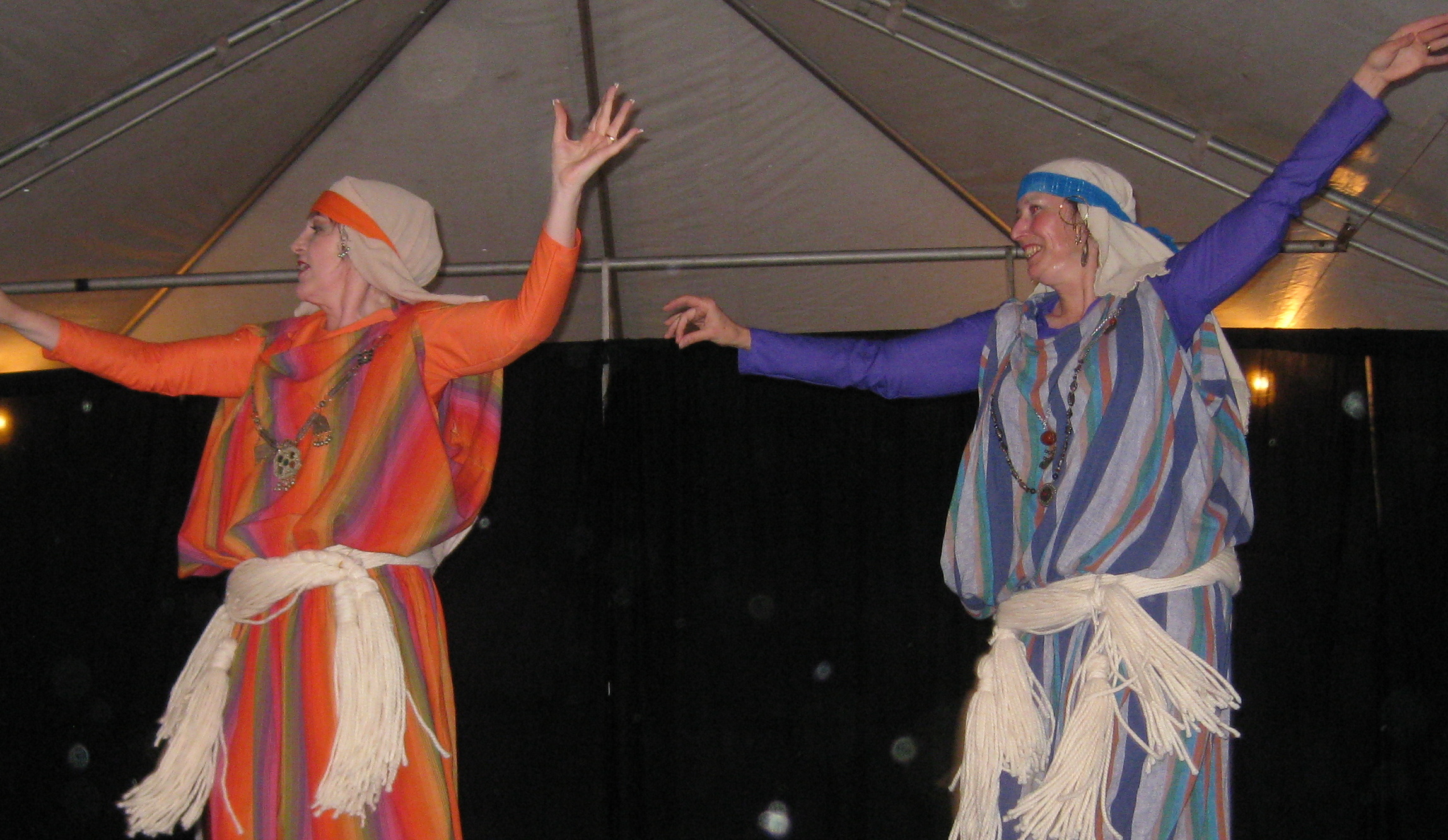
 Click here for a Youtube clip Click here for a Youtube clip
|
TUNISIA -- The traditional women's dance style is much the same
from region to region. The most usual rhythms are 6/8 or 12/16,
rather than the 4/4 of Egypt, and the slower rhythms have a smooth
quality. The dance is characterized by dainty light-footed steps and
vigorous horizontal movements of the hips, accentuated by the full-ness
of the melia, the outer garment, and the flying tasseled ends of the belt.
Yet the carriage of the head remains utterly smooth and the torso held
still. The gliding gait of a Tunisian dancer is aptly described in a popular
Tunisian song "You are like a ship, "Salha, sailing the seas, Salha".
Indeed, while dancing, the costume resembles the sails and banners
of a ship, moving in the wind as the dancer sails smoothly by!
|
BERBERS: Berber people, or Amazigh, were the
native population believed to have inhabited the area from at least 10,000 B.C.
Since the Muslim conquest of North Africa in the seventh century, a large number of Berbers
inhabiting the Maghreb have spoken varieties of Maghrebi Arabic, Berbers are not
an entirely homogeneous ethnicity and they encompass a range of phenotypes, societies and
ancestries. The unifying forces for the Berber people may be their shared language, belonging
to the Berber homeland, or a collective identification with the Berber heritage and
history.
|
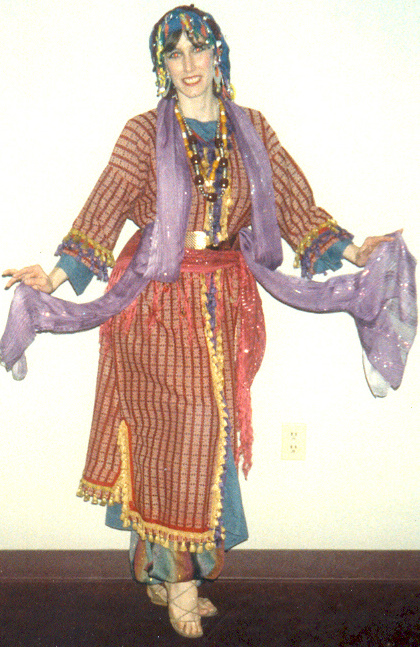
|
| MOROCCAN TRAY DANCE: shows the dexterity and skill of the dancer,
as she balances a tray with candles on her head. Za'hra performs this to the
song Lala Fatima or Lady Fatima. |
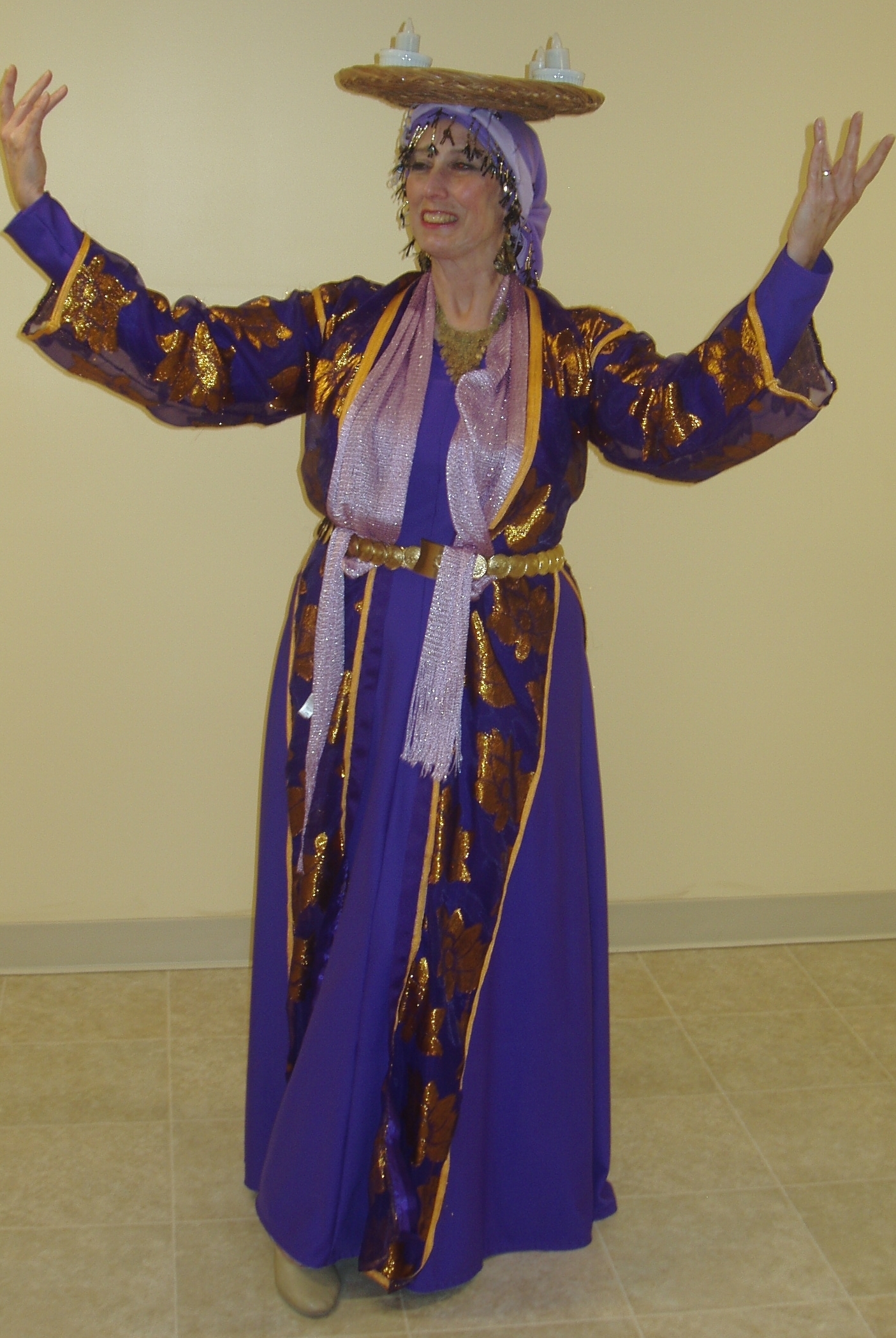
 Click here to view a Youtube clip Click here to view a Youtube clip |
 |
KABYLE: This is an Algerian dance from the Kabyle region of Algeria, part of the Tell
Atlas mountains and is located at the edge of the Mediterranean Sea. The area is populated
by the Kabyle, a Berber ethnic group, the second most populous Berber people after the
Chleuh in Morocco. They speak the Kabyle variety of Berber.
 Click here to view a Youtube clip Click here to view a Youtube clip
|
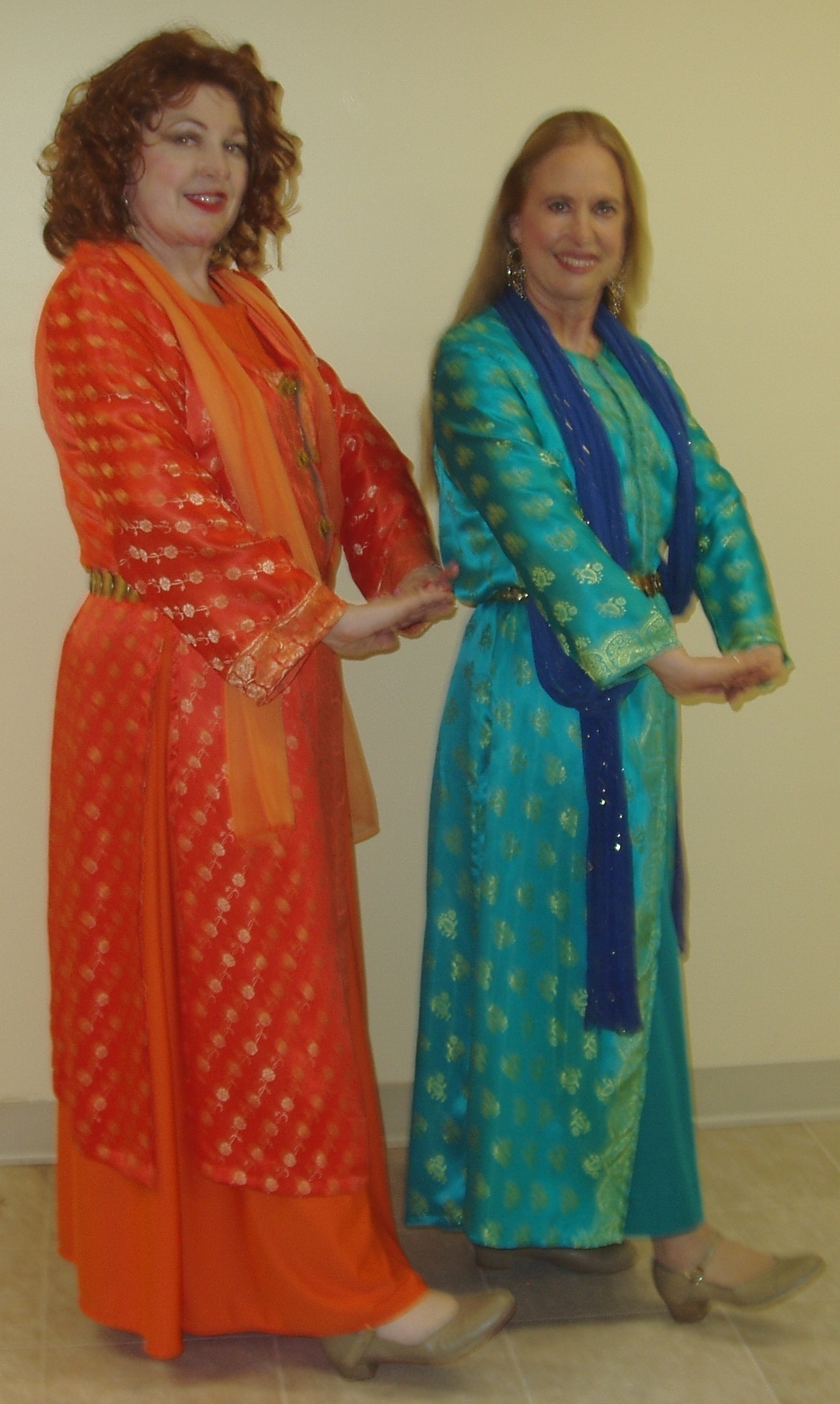
 Youtube clip pending Youtube clip pending
|
SHIKATT: (Morocco) Female dancers
have a dubious reputation in the Near and Middle East. On one hand, music and dance is an
integral part of all the cultures of this vast area, but given Islamic strictures on the
behavior of women, dancers are not considered proper members of society. The Sheikatt
of Morocco are such a group. The Arabic world Sheik means more than the Western idea
of a chieftan. The word literally means A wise and learned one.
And the feminine version is Sheika. For at least 3 days, sometimes more, proceeding
the signing of the marriage contract, all-day women-only parties are hosted in the home
of the bride's family, to display her dowry clothing and beauty. The all-female
Sheikatt musicians and dancers are hired to liven things up. The Sheikatt
sing impromptu songs poking fun at the family and guests.
These women are often widowed or divorced and have nobody to take care of them. It
is a highly stigmatized way to earn a living. However, everyone dances the Sheikatt
at home for fun, and at parties,
with no stigma attached. |
AHOUCH: Ahouach (a.k.a. Ahwach, Ahwash) refers to a
folkloric style of music and associated dance from southern Morocco. an Ahwach session is
held by a number of performers (sometimes more than 20 performers) from both men and women
(in some regions; only men) playing on the rhythms of drums while chanting, Ahwach is
famous in the Amazigh (berber) regions of Morocco, especially, the region of Ouarzazate,
Zagoura, Souss.
The root h-w-sh means "dance", but the term ahwash encompasses 1) general idea of (musical)
performance 2) An evening of song and dance 3) a single piece and 4) the dance section of
a single piece.
It is an exclusively Berber village music, probably unchanged for centuries or longer.
Ahouach texts emphasize the submission of the individual to the community. Typically,
it consists of two large choruses engaging in call-and-response vocals, accompanied by
instrumentalists and dancers. Since this music requires anywhere from 20 to 150 participants,
it is not easily portable and so rarely heard in the cities. |
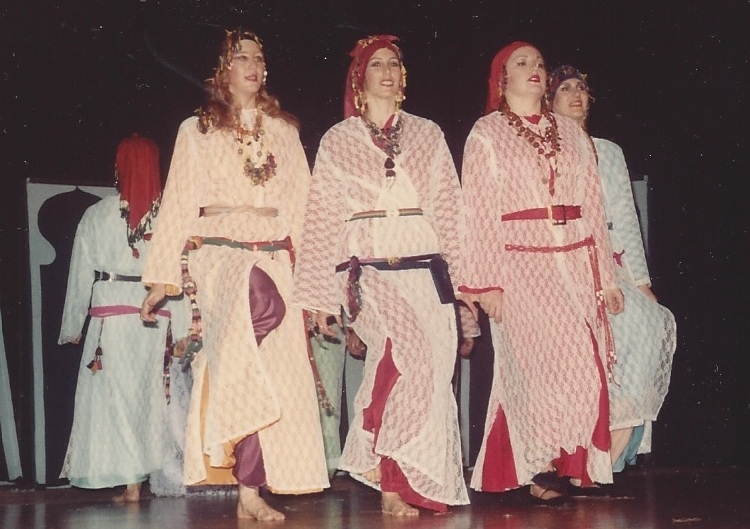 |
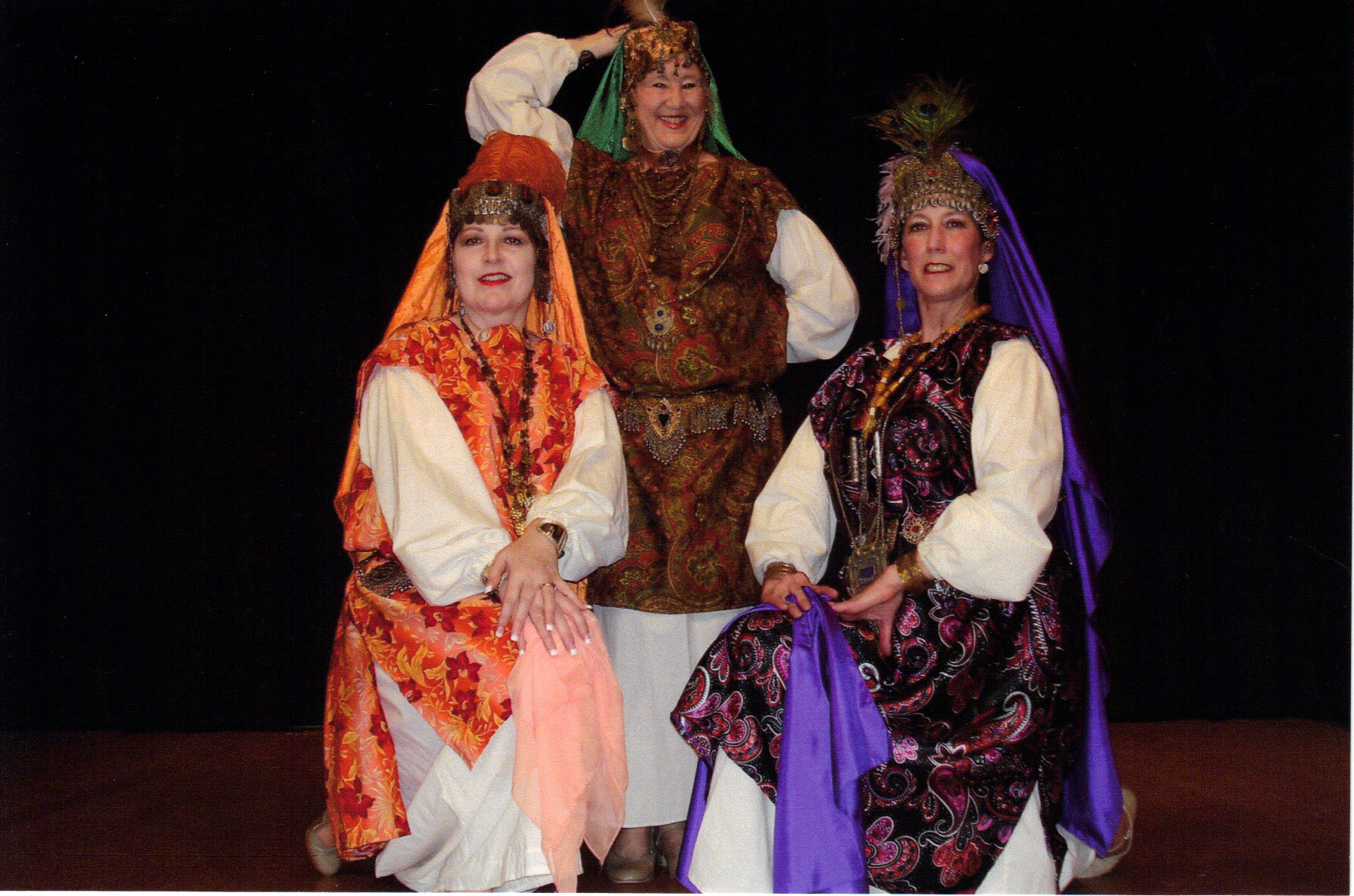
 Click here for a Youtube clip Click here for a Youtube clip
|
WALAD NAYEEL: (Fr. spelling Oulid Nail) Algeria The famous
public dancers of Algeria were the Children of Sandals - the Walad Nayeel.
They traveled to the oasis towns of the Sahara to earn their dowries as dancing girls.
For generations the young girls of the tribe have been purveyors of entertainment and
pleasure to Saharan travelers. Sometimes they even took a patron, much like the geisha
of Japan. After earning their dowries in this manner, which in no way affects their
reputation at home, they return to their people to marry and live according to strict
Muslim standards. They perform in their multilayered finery, with their impressive crown
headdresses, and mesmerized all who saw them.
|
| KHALIZI: In Saudi Arabia the law of the Koran and
the secular state are the same, called the Sharia. This law dictates that women
may only be in the company of males of their own family. So when parties are given, the
women and the men celebrate separately if not related. The women dance for one another,
using their voluminous beautiful national dress, called the thob. The costume
dictates the dance movements. As Egyptian hip isolations would never be seen under this
costume, other movements are done, such as displaying the dress itself, showing off the
beautiful 22 carat gold bracelets their husbands buy them, shaking their long hair, or
shimmying their shoulders. |
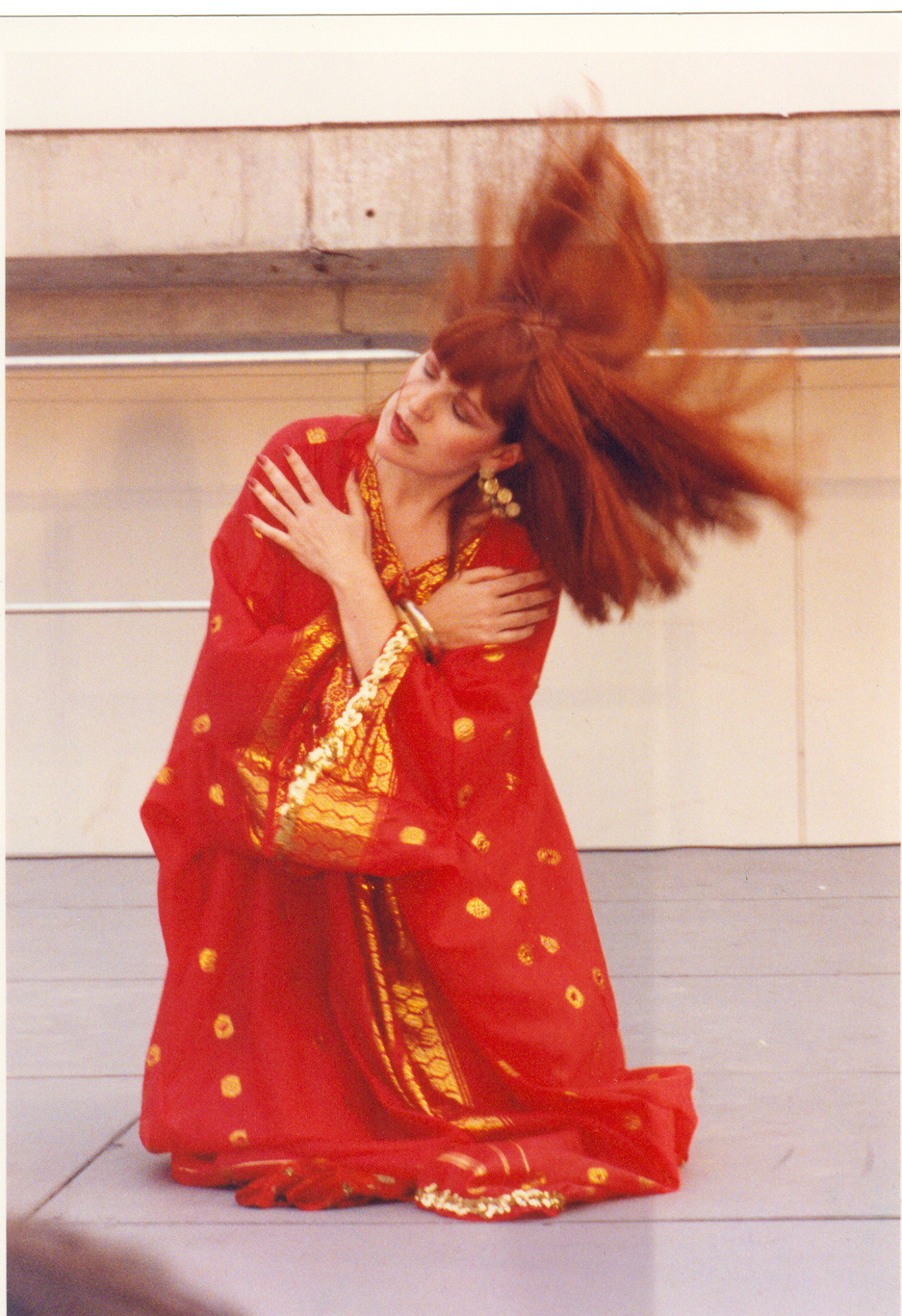
 Click here to view a Youtube clip Click here to view a Youtube clip
|
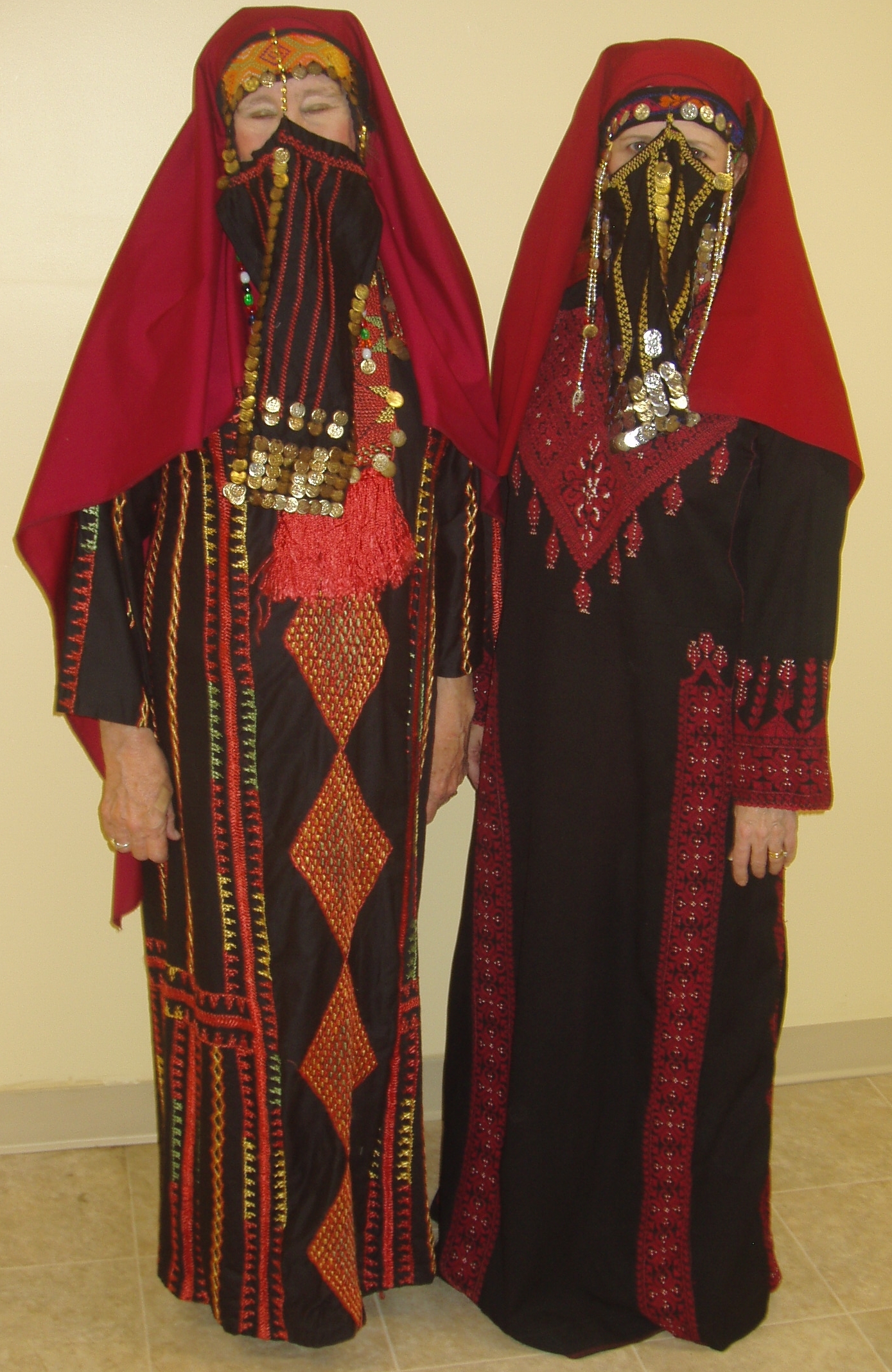
 Click here to view a Youtube clip Click here to view a Youtube clip
|
BEDOUIN: Picture an oasis in the desert. It is dusk, and a
campfire has been lit. The animals have all been fed, and the nomadic Bedouin
people, called Badawiya in Arabic, are preparing for evening. One of the men
picks up a nay (flute) and another the bender (frame drum). As they start to play,
some of the Bedouin girls come together to dance. Notice the beautifully hand-embroidered
dresses and the decorated face-veils. Not only do these niqab, or face veils,
follow tribal traditions of female modesty, they also serve a very practical purpose
of keeping sand from blowing in the womens' faces.
|
| DABKE: Lebanon/Jordan/Syria/Palestine (the Levant)
The Dabke is a line dance popular in Lebanon, Syria, Jordan and Palestine, the area that
is called the Levant. It is performed at every party and family social occasion. Rather
simple in its form in the village, the professional dance troupes make the Dabke a
precision drill, with plenty of fast-moving sharp steps.
| 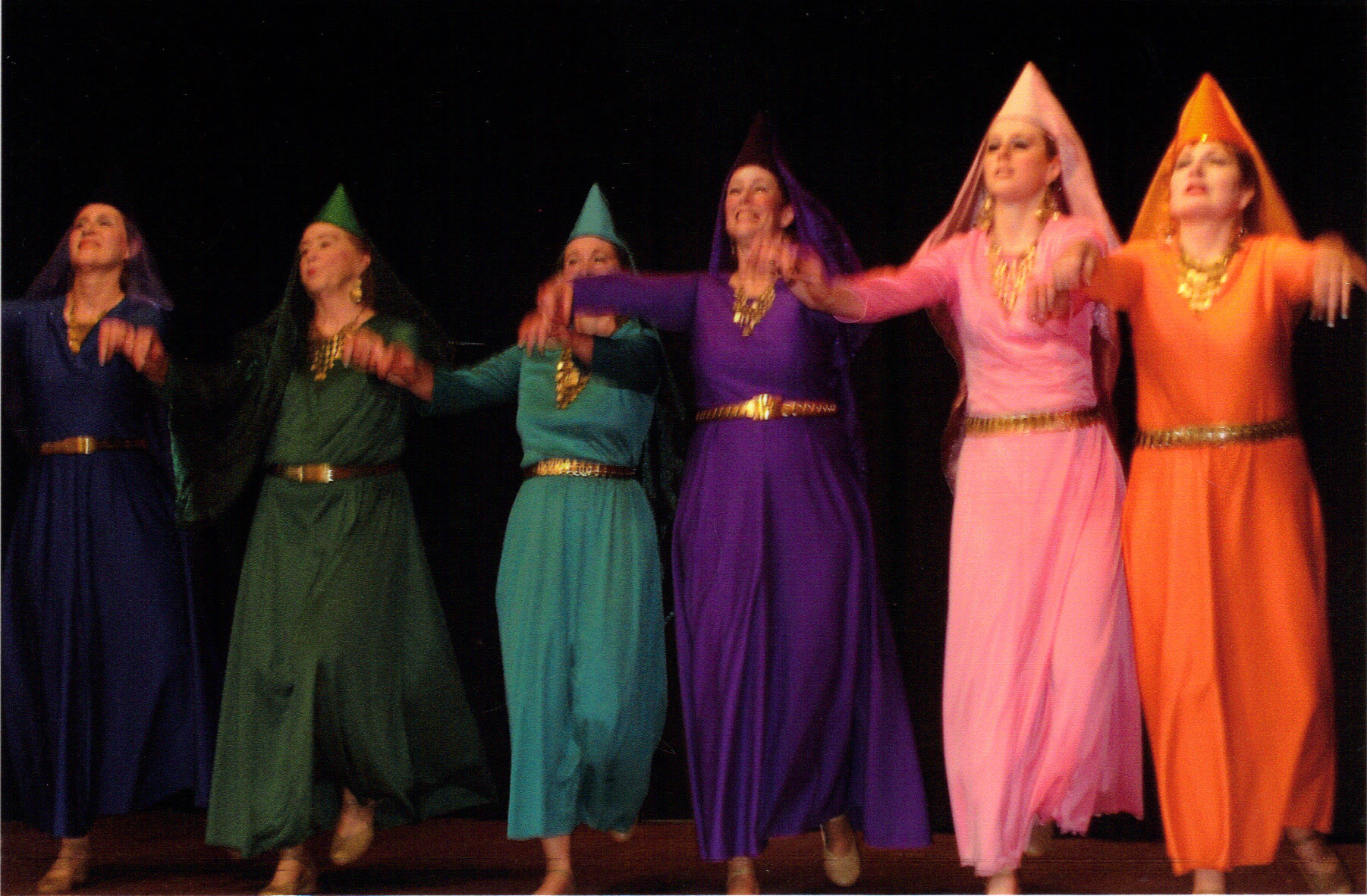
 Click here to view a Youtube clip Click here to view a Youtube clip
|

 Click here to view a Youtube clip Click here to view a Youtube clip
|
CLASSICAL ORIENTAL DANCE: As ballet was
crystllized and formalized from the court dances of Europe, which themselves were refined
from the folk dances of north and western Europe, so is the classical Oriental Dance
refined from the folk dance of Egypt. The proper name is Oriental Dance because in Arabic
the dance is called Raks Sharki, which means dance of the east. The French translated
this to danse orientale, thus in English, the Oriental Dance. Unfortunately in the US,
if you say Oriental Danse people assume you mean the Far East, not the Near East. As
western ballet has had its great stars, so too has the world of Oriental Dance. The 50s
were they heyday of of this dance, performed in the great nightclubs of Cairo by Samia
Gamal, Tahia Carioca, and in the 70s by Soheir Zaki and Nagwa Fouad of Egypt, and Nadia
Gamal of Lebanon.
|
| RAKS AL BALAS: (Egypt): The word for peasant in
Arabic is fellaha or in the plural, fellahin. The dances from the
countryside are very rhythmic and full of sharper, bigger movements, in contrast to the
smoother, more lyrical and flowing movements of the classical Danse Orientale In
this presentation, 2 Egyptian girls dance together, on their way to the well with the water
jars, called balas flirtatious yet innocent, and at the end of the song, the man
singing bids the girl to go fetch her father, as he wants to discuss a wedding!
| 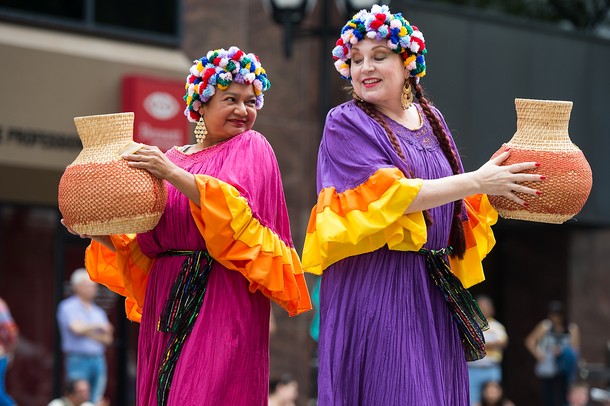
 Click here to view a Youtube clip Click here to view a Youtube clip
|
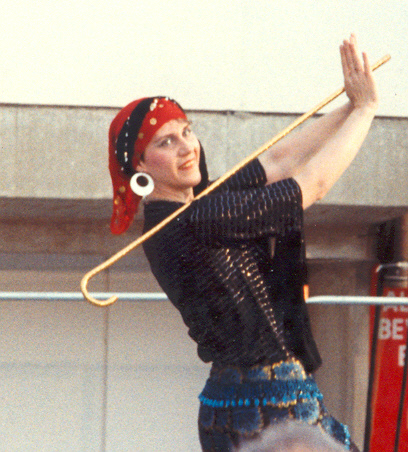
 Click here to view a Youtube clip Click here to view a Youtube clip
|
CANE DANCE: Raks Al Assaya (Egypt) In Egypt, as in many parts
of the world, objects from everyday use are incorporated in the folkloric dances.
Such is the case of the walking stick. When men perform the dance, the Raks Tahteeb,
they use large bamboo canes, and the dance is mock combat. The men swing the canes menacingly,
and strike the other's cane. But when women perform the dance, all of the warlike
character is gone, replaced with a light, flirtatious demeanor, which is typical
of women's Egyptian folkloric dance.
|
| BASKET/SWORD/CANDELABRA: (Egypt) In the Near East
objects from everyday or not-so-everyday life sometimes become props in the dance.
Baskets or water pots are balanced on the head in a display of grace and skill. The
Raks al Saif, or Sword Dance, probably came into being when a dancing girl borrowed
a soldier's weapon while entertaining the troops. In any case the dance is often done
at weddings, to cut away the evil spirits who might try to ruin the proceedings.
Carrying baskets or water pots on the head kept the hands free for other tasks, and was an
efficient way to carry these objects. The sight of an Egyptian nightclub dancer with a fully
lighted shamadan, or candelabrum on her head, is perhaps the most extravagant
extension of this idea.
| 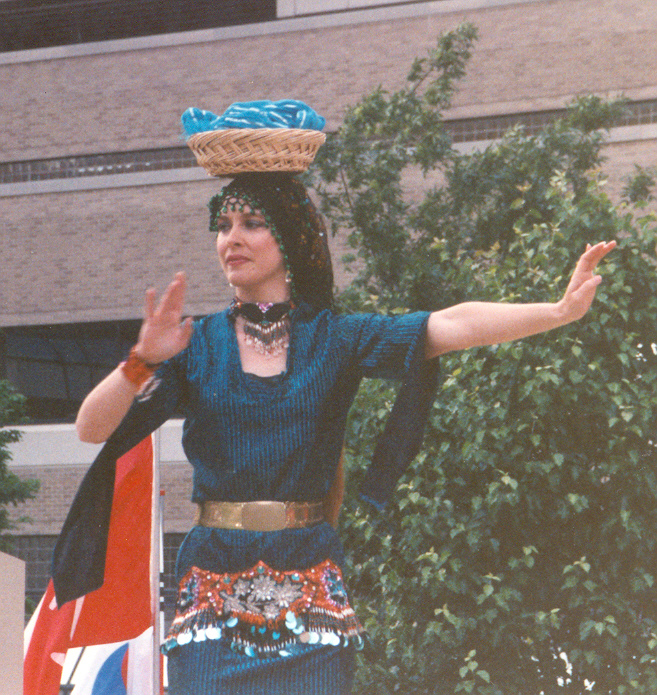
 Click here to view a Youtube clip Click here to view a Youtube clip
|
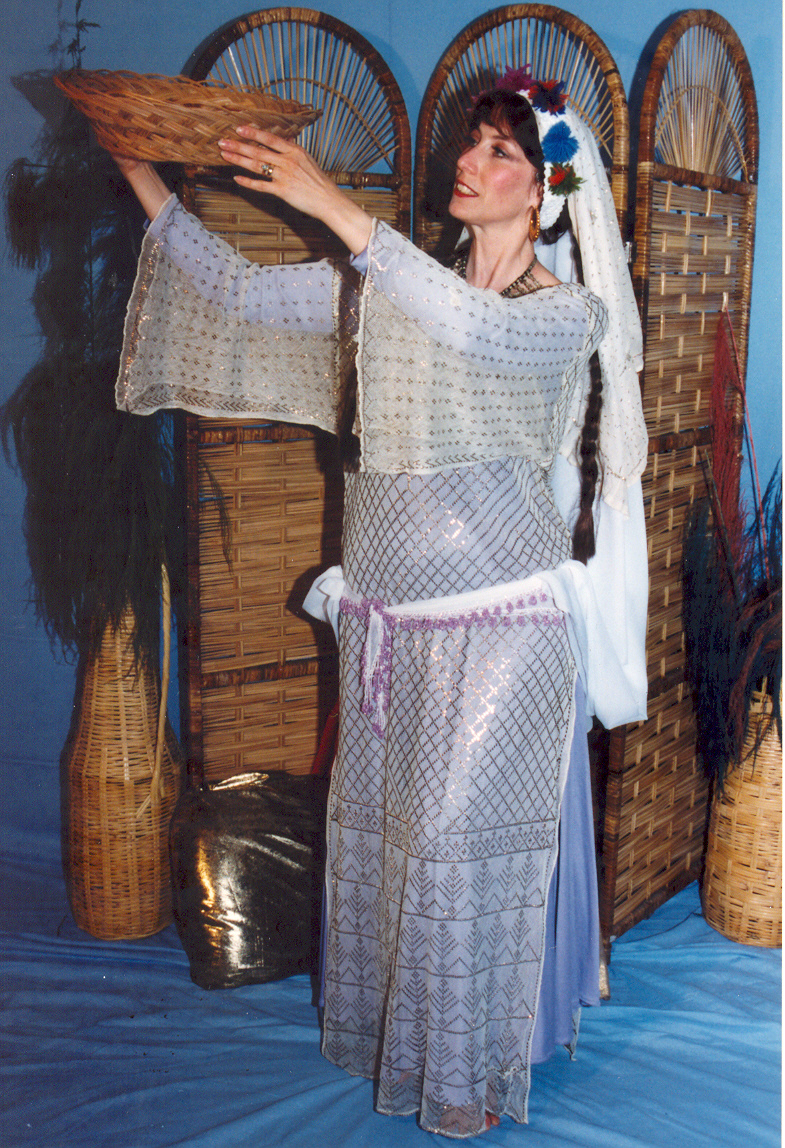
 Click here to view a Youtube clip Click here to view a Youtube clip
|
SAIDI: the Saidi region is in Upper Egypt,
which is actually in southern Egypt. This might seem confusing until you realize that the
headwaters of the Nile are in southern Egypt, thus upriver is in the south, as the river
flows north to empty in the Mediterranean. This region is near the Sudan, and the dance
movements are very sharp and strong, which they share with their east African neighbors.
Said(sai-ehd) means from the south and the female Egyptian dancers keep an air of
innocent, happy flirtation while performing their dances.
|
HORSE DANCE: Raks Al Kheil or Raks Al Hissan In
the Arab world the beautiful Arabian horse is a treasured animal, and the Bedouin consider
them like family. Any scarcity of food or water does not deprive the animals of their
rations, so well-loved are they, This dance takes its inspiration from the movements of
the horse, especially the trained Arabic dancing horses, from which the famous Lipizzaners
of Austria were descended. The dancer imitates both rider and horse.
| 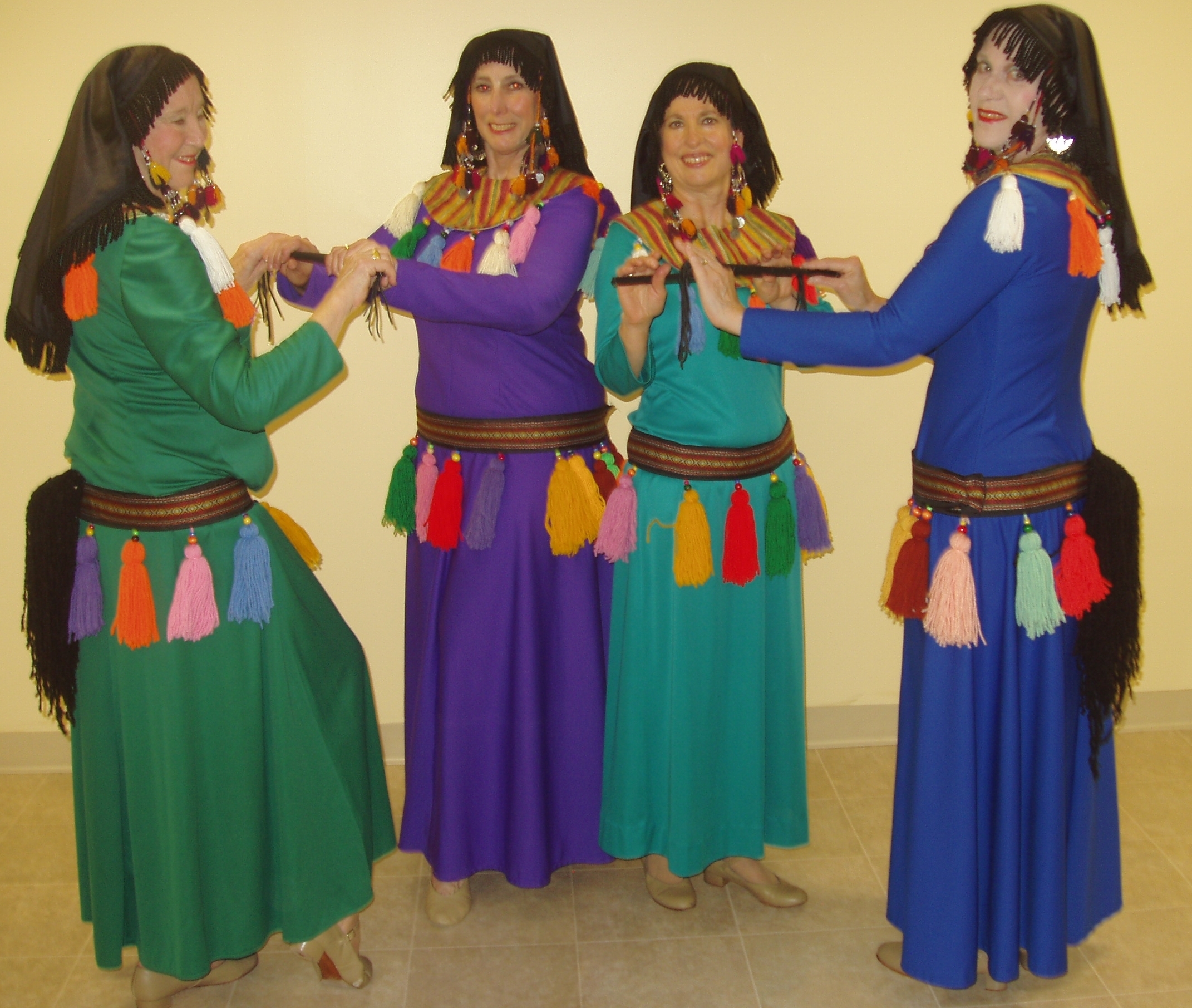
 Click here to view a Youtube clip Click here to view a Youtube clip
|
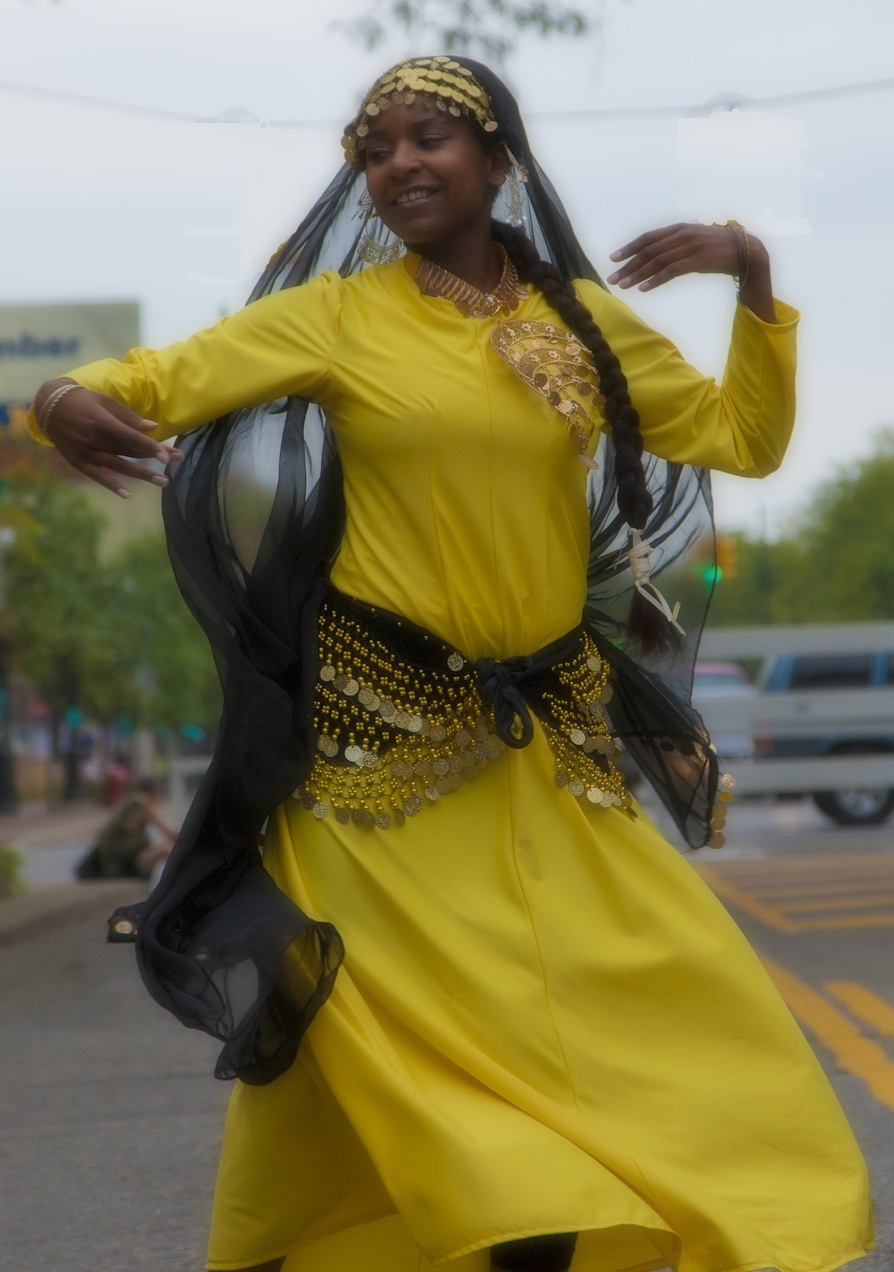
 Click here to view a Youtube clip Click here to view a Youtube clip
|
HAGGALAH: The Bedouins of the western Egyptian desert descended
from the Arab invaders who swept through North Africa in the 11th century.
They settled originally in Libya, and moved into Egypt about 200 years ago.
The dance from know as Haggalah is particular to these people, and is a
variant of the Arab Bedouin dance found throughout the Arab world. In its old form,
veiled females, singly or in pairs, danced before groups of clapping youths.
The mens' song extolled the beauty of the dancer. With the modernization and
settlement of these tribes, the dance has changed dramatically. The Hagallah
is chaste and good-humored, but the encroachment of the outside world and the
probable influence of Islamic fundamentalism have enforced a greater separation
of the sexes, to the point that the women still dance, but only for each other.
|
| GHAWAZEE: (Egypt) TThe Gypsies, who research tells
us came first from India, emigrated in two waves, one to Europe and the other to north
Africa and Spain. In fact, the English word gypsy comes from the name Egypt.
In Egypt the dancing gypsy tribes were known as the Ghawazee, but the name has no sure
meaning. Scorned by proper society for their brazen ways, no wedding or other social event
was considered complete without them. Bursting upon the scene in their bright, gaudy
costumes, playing the finger cymbals to accompany their dances, these women were such
a distraction to Napoleon's troops when they were there in the late 1700's, that when
he complained to the Ottoman ruler in Cairo, he banished the Ghawazee to
upper (southern) Egypt. That didn't stop them for long, after all, these women
broke all Muslim conventions, dancing in public, not wearing the abaya, the
black cover-up garment, when outside of their homes, and they knew where to get
ahold of alcoholic beverages, shame, shame, shame!! There is only one family left
in Egypt of the Ghawazee, the Binat Maazin, or the daughters of Maazin.
Now that they are getting older, unless they marry and have daughters who will continue
this tradition, the real Ghawazee may disappear.
| 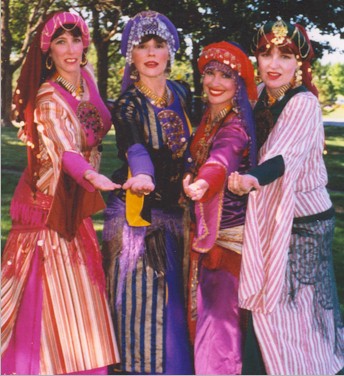
 Click here to view a Youtube clip Click here to view a Youtube clip
|
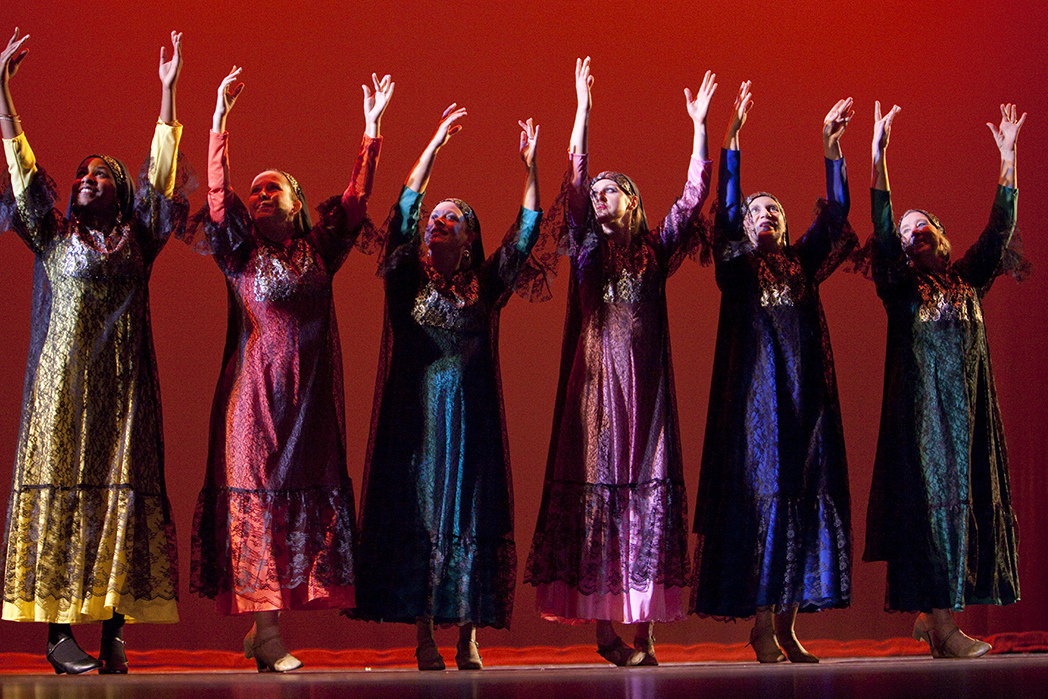
 Click here to view a Youtube clip Click here to view a Youtube clip
|
NUBIAN DANCE: Nubia, in the southern part of Egypt and the northern part of the
Sudan, has been known from antiquity. The darker people pictured
in the hieroglyphs are Nubians. Nubian dance and music is happy
and catchy. Today's dance, Sukkar, Sukkar, Sukkar, has the singer
Ali Hassan Kuban, Nubia's most famous male singer, telling a lovely lady Your
eyelids are sweeter than honey, you are the queen of all women. During my sleep I dream
of you and when you are by my side, my heart starts to fly. Sugar, sugar, sugar... Your
eyes makes all men go crazy. And your smile is melting me. Sugar sugar sugar.
|
| ARMENIAN DANCE: TThe folk dances of Armenia are
steeped in rich tradition and long history. Armenia, one of the oldest Christian nations,
has a style of dance in which, like their neighbors, the Georgians, the men are fiery and
acrobatic, and the women are the epitome of grace and regal bearing. After the long
association with the Soviet Union, much of the dance was very ballet'd in the
style of the large Soviet folkloric troupes. There exists in Armenia today two schools
of thought on the dance: pure folkloric with only native instruments, or the more
theatrical style, and neither side tolerates the other very well. In any case the
dances are lovely and lyrical, and sure to delight.
| 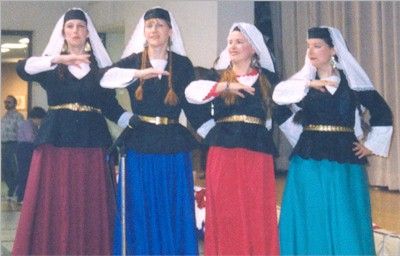
 Click here to view a Youtube clip Click here to view a Youtube clip
|

| AI NACHUME/SHEKHANI: (Caucasus)
The Caucasus area, NE of Asia Minor, is home to many peoples. The earliest groups were
the Georgians and Armenians, related by culture and their Christian faith. Other peoples,
such as the Azerbaijanis, Ossetians, Dagestanis, came in later with migrations of the
Central Asian Turks. The dances of the Georgians are legendary, with the men dancing on
their bent-over toes, to resemble horses, and their war dances with swords flashing. In
contrast, the women are the epitome of womanly grace and charm, doing their courtly,
feminine dances.
|
| ROMANY: The gypsies spread all over the world, but
Central Europe and the Balkans are two of the places where they are best known. The style
of this dance is Dunyavi, that is to say, a combination of Spanish, Indian and Turkish
gypsy styles. The music is an unusual 9/8 rhythm called Karshilama, which is particular
to the Balkan region. These gypsies are full of fire and flair as they perform their
energetic dances. |
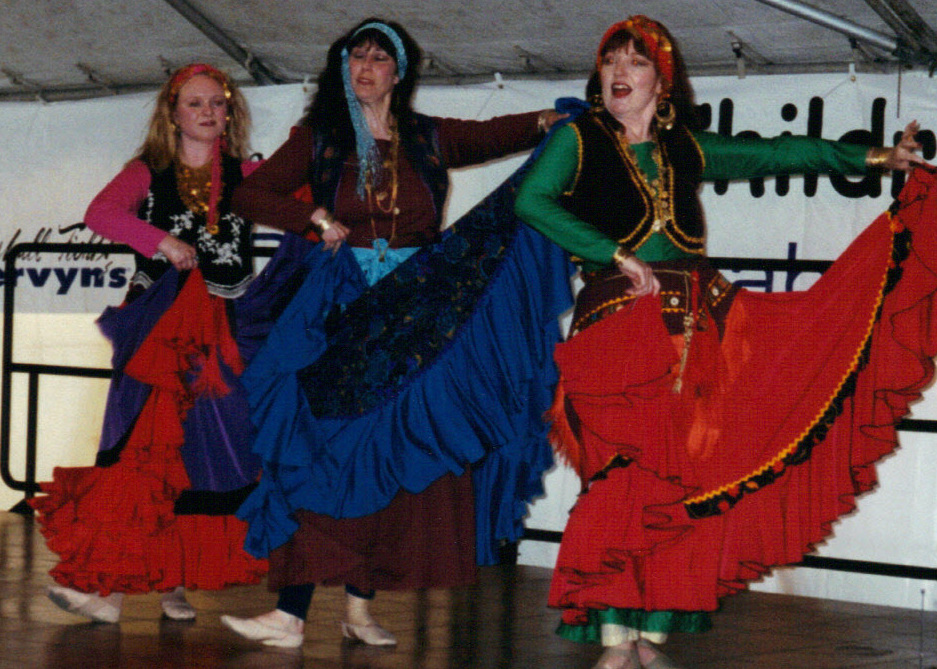
|
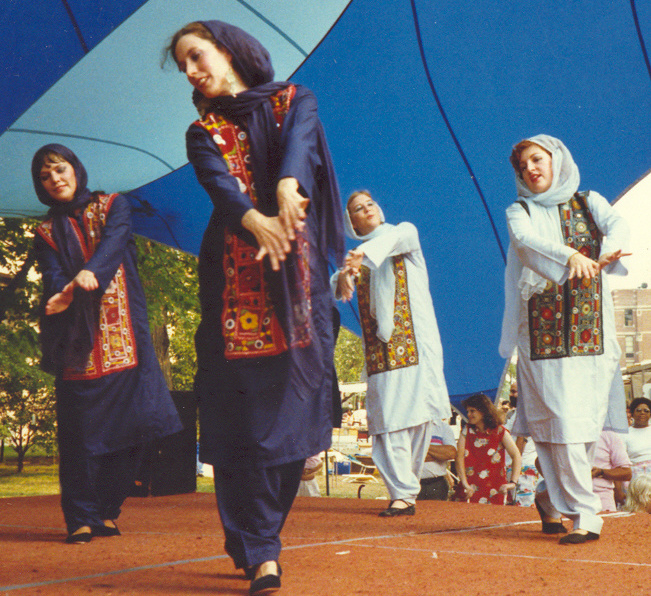
 Click here to view a Youtube clip Click here to view a Youtube clip
|
SIND PAKISTANI: As in many countries, the dance
of the seacoast of Pakistan is different from those of the mainland. In this dance we see
motions of the ocean breezes, the seagulls, the waves, and getting in the boat. Sung by
one of Pakistan's stars, this song is called Mazi Ray and the singer is telling his
beloved that even stormy seas won't keep him away from her.
|
| PERSIAN CLASSICAL SOLO: Classical Persian dance is
a style of concert dance that evolved from court dance. An important era influencing
Persian dance was the Qajar dynasty which reigned from 1795 to 1925. In this period, that
dance began to be called classical Persian dance. Dancers performed artistic dances in
the court of the Shah for entertainment purposes such as coronations, marriage
celebrations, and Norouz celebrations (Iranian new year). The rise of the Qadjars
liberalizes people's attitudes toward dancing, although it remained in the royal court and
among the elite and bourgeois families. The court dancers elevated respect for dance to an
art form.
| 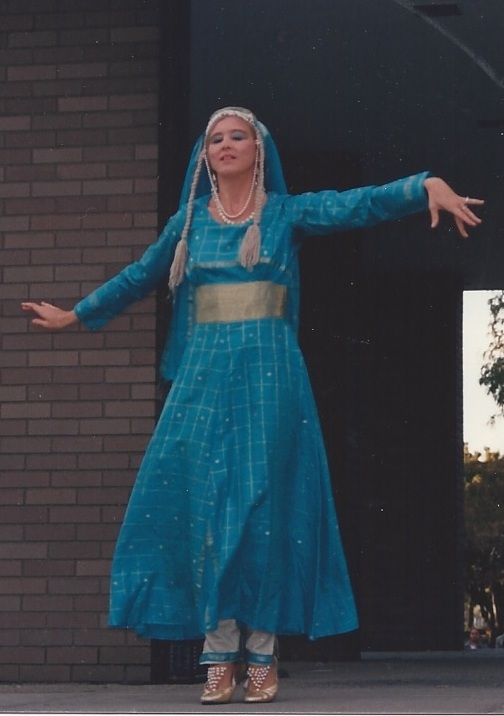  Click here to view a Youtube clip Click here to view a Youtube clip
|
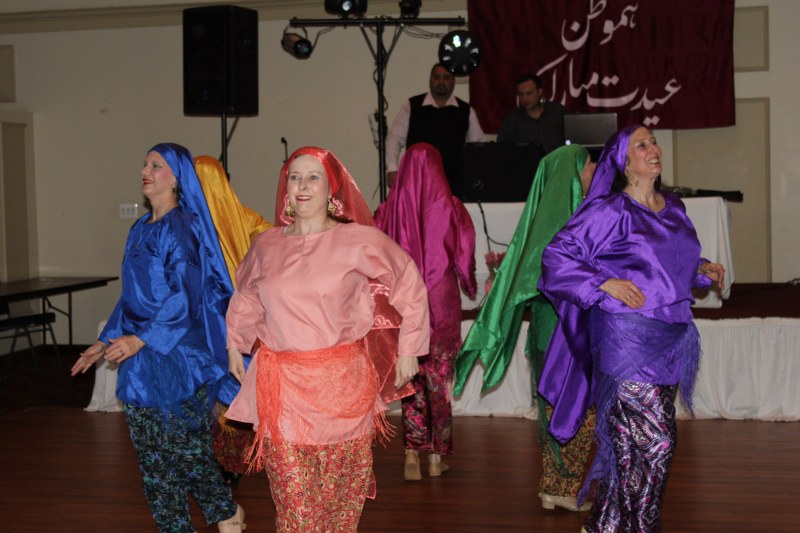
 Click here to view a Youtube clip Click here to view a Youtube clip
|
BANDARI: Bandari music stems from Iran's south,
around the Persian Gulf region and was used by sailors and harbour-workers for centuries.
It is a rhythmic type of dance music played fast and slow using quarter tone that can be
vocalized and played. It is played mostly in weddings and other celebrations. The name
bandari means 'of the port people' and comes from the Persian word bandar meaning port.
|
| GHASEM ABADI: The Gilaki region, in NE Iran, is
home to the Rice Harvest Dance. As in many cultures, dances are often formed from everyday
chores. This dance shows movements of separating the chaff, tossing the rice in the
baskets, sowing the rice seed. The distinctive skirts have ribbon trim, but in older
times, were actually long pieces of material added together to make the skirt with rows of
vertical colors.
| 
 Click here to view a Youtube clip Click here to view a Youtube clip
|
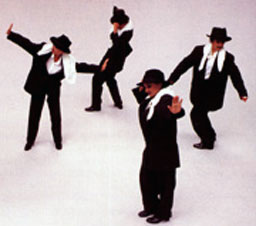
 Click here to view a Youtube clip Click here to view a Youtube clip
|
JAHELI: This humorous Iranian piece is a
playful imitation of the machismo style of dance done by working class men of South
Tehran. Also called Baba Karam, the first woman to dance this was Jamila, an Iranian
dancer. Now several dance troupes have added this humorous piece to their repertoire.
|
| KURDISH DANCE: The Kurdish people, or are an Iranic
people native to Southwest Asia, mostly inhabiting a
region known as Kurdistan, which includes adjacent parts of Turkey, Syria, Iran, and Iraq.
They speak the Kurdish language, which is a member of the Iranian branch of Indo-European
languages. The Kurds number about 38 million, the majority living in Southwest Asia, with
significant Kurdish diaspora communities in the cities of western Turkey, in Armenia,
Georgia, Israel, Azerbaijan, Russia, Lebanon and, in recent decades, some European
countries and the United States.
Kurdish dance (Govend, Hilperke) is a group of traditional hand-holding dances similar to
those from the Balkans and Eastern European countries. It is a form of round dancing, with
a single or a couple of figure dancers often added to the geometrical centre of the dancing
circle. According to the Encyclopaedia of Islam, Kurds sing and dance in all of their
festivals, birthdays, Nowrooz, marriage and other ceremonies. Its noteworthy that these
folkloric dances are mixed-gender which distinguishes the Kurds from a few other neighboring
Muslim populations.
| 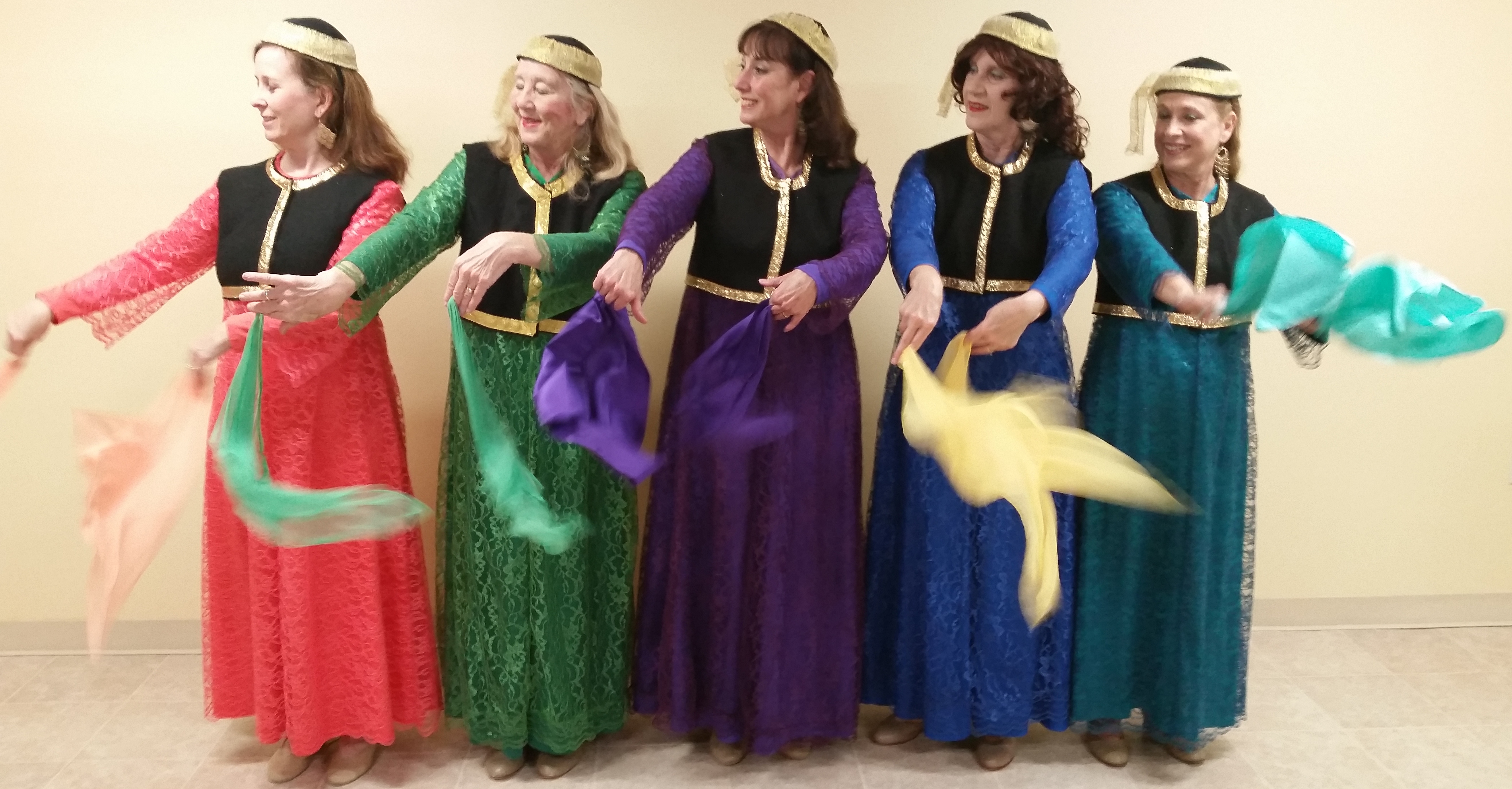
 Click here to view a Youtube clip Click here to view a Youtube clip
|
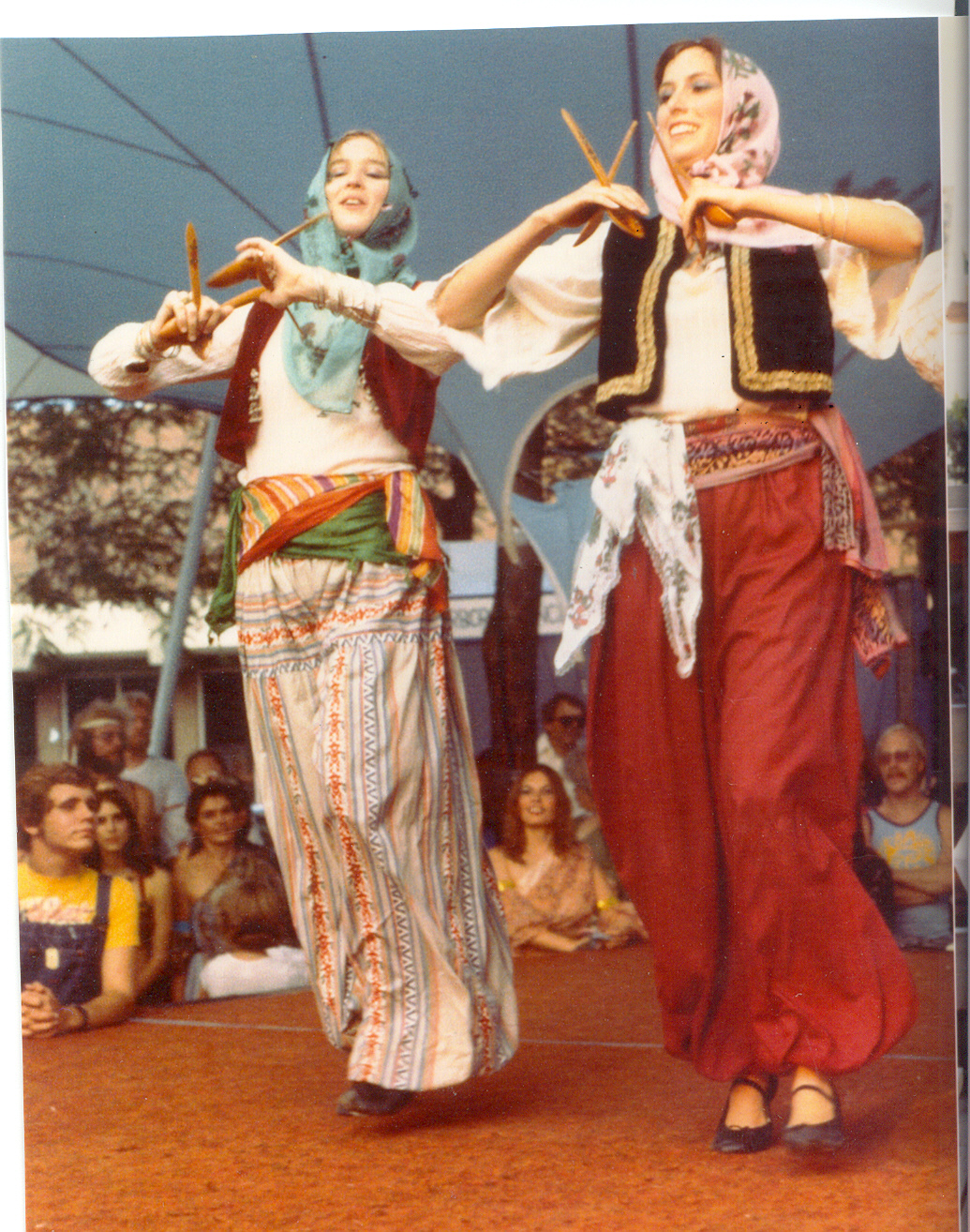
|
Spoon Dance: Turkey - originally from Turkmenistan in
Central Asia, the Asia Minor Turks have a
rich dance repertoire, varying from region to
region. Many dances were assimilated from
the native Greek and Armenian styles they
encountered from the inhabitants of the area.
| |
 Other Regions Include: Other Regions Include:
- * Armenia * Afghanistan * Syria * Turkey
 General Styles: General Styles:
-
* Beladi * Debke * Gypsy (Ghawazee, Balkan, Mogul, Dunyavi) * Classical
Danse Orientale

| | ©
2004-2019 Troupe Ta'amullat. All rights reserved |
|
|

![]()
![]() Regions: The Maghreb, or northwest part of Africa,
is comprised of Morocco, Algeria and Tunisia.
Regions: The Maghreb, or northwest part of Africa,
is comprised of Morocco, Algeria and Tunisia.


![]() Click here to view a Youtube clip
Click here to view a Youtube clip



















![]() Other Regions Include:
Other Regions Include:![]() General Styles:
General Styles:![]()